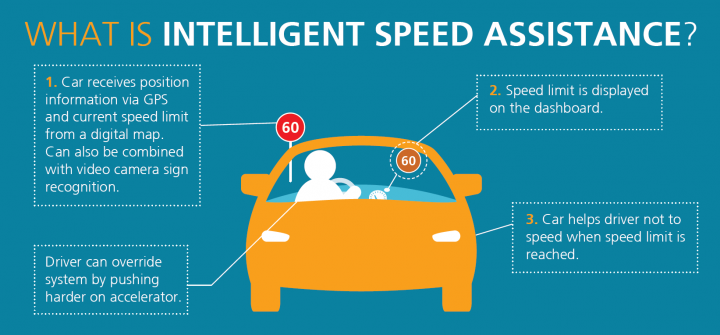
The technology uses a combination of cameras and GPS to detect the speed limit for a given stretch of road, then inhibits engine power to ensure drivers don’t stray over the limit. ISA can be overridden temporarily, for example when overtaking, by pressing the accelerator hard to the floor. The system can also be disengaged, though it will be operational by default every time a vehicle is started. It is estimated that widespread adoption could reduce the EU’s 25,000 road fatalities by around 20 per cent.
ISA is just one of several safety features the EU plans to introduce under its revised General Safety Regulation, the details of which have just been agreed. According to the Department of Transport, the UK will also adopt the measures, regardless of the outcome of Brexit. Other mandatory systems for cars under the new regulation will include a warning for driver distraction and drowsiness, cameras/sensors for reversing, advanced emergency braking, lane keeping assistance and a ‘black box’ data recorder for incident reporting.
"Every year, 25,000 people lose their lives on our roads,” said Poland’s Elżbieta Bieńkowska, EU Commissioner for Internal Market, Industry, Entrepreneurship and SMEs.
“The vast majority of these accidents are caused by human error. We can and must act to change this. With the new advanced safety features that will become mandatory, we can have the same kind of impact as when the safety belts were first introduced. Many of the new features already exist, in particular in high–end vehicles. Now we raise the safety level across the board, and pave the way for connected and automated mobility of the future."
The General Safety Regulation has been formally agreed by the European Union and is now subject to ratification by the institution's Parliament and Council. According to the EU, it expects that the proposed measures will help save lives and avoid at least 140,000 serious injuries by 2038. The EU's long-term goal is to approach zero fatalities and serious injuries by 2050 under its ‘Vision Zero’ plan.
“This is a landmark day for road safety,” said Joshua Harris, director of campaigns for road safety charity Brake. “These measures will provide the biggest leap forward for road safety this century. These lifesaving measures come at a vital time, with road safety in a concerning period of stagnation with more than 70 people still being killed or seriously injured on British roads every day.”
The new directives were also praised by Richard Cuerden from the UK’s Transport Research Laboratory, an organisation that helped shape the regulations.
https://vimeo.com/303505393
“The advanced safety measures for new vehicles will provide state of the art protection to all road users,” he said. “Intelligent Speed Assistance and Drowsiness and Distraction Recognition will support drivers in their ongoing tasks; Autonomous Emergency Braking and Emergency Lane Keeping will intervene in the most critical situations to avoid a crash; and improved crash tests will ensure that injuries of occupants as well as pedestrians and cyclists are minimised in the remaining collisions.”





Collaboration to address viable solutions for VAWG database
<blockquote>address the lack of standardisation, coordination, and collaboration of gender disaggregated data intelligence across various regions,...